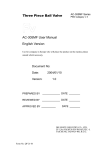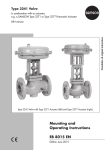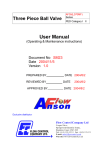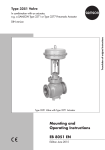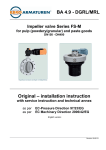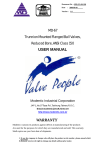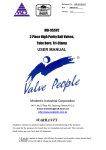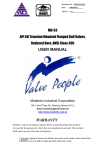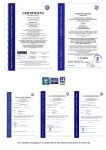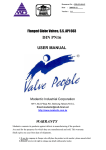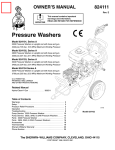Download Three Piece Ball Valve AC-305MF User Manual English Version
Transcript
Three Piece Ball Valve AC-305MF Series PED Category I, II AC-305MF User Manual English Version Use for company in Europe who will place the product on the market, please amend which necessary. Document No: Date: Version: 2004/01/10 1.0 PREPARED BY DATE REVIEWED BY DATE APPROVED BY DATE DIE ERSTE INDUSTRY CO., LTD. 5F-1,No.936,WEN-SIN ROAD,SEC. 4, TAICHUNG, TAIWAN 406, R.O.C. Form No. QF-21-01 Contents 1. General Precautions Page- 2~3 2. Product Description Page- 4 3. Design Specification Page- 5 4. Pressure Temperature Ratings Page- 4 5. Delivery Condition and Storage Page- 6 6. Installation and Operation Page- 6~8 7. Maintenance Page-9~11 8. Torque Data Page-11 9. Corrosion Data Page-11 Form No. QF-21-01 1 1. General Precautions a. Material Selection: The possibility of material deterioration in service and the need for periodic inspections is depended on the contained fluid. Carbide phase conversion to graphite, oxidation of ferrite materials, decrease in ductility of carbon steels at low temperature (even in applications above -29к) are among those items. Even information about corrosion data is provided in this user manual, the user is requested to take attention or consideration to determine the suitability of material in their application. b. Pressure-Temperature rating: The Pressure-Temperature rating is considered for static pressure. Please refer to P & T rating section on page 9 for working precaution. The allowable temperature is between R.T. and 200к do not exceed the temperature range to avoid danger accident happen. c. Fluid thermal expansion: It is possible, when the ball valve is in closed condition, the sealed cavity within the valve body to be filled with liquid. If this liquid is not released, by partially opening the valve or some other means, and it is subject to a temperature increase, excessive pressure sufficient to cause pressure boundary failure can be generated. However our products have pressure self-relief seat to prevent pressure built up, user is recommended to prevent that the pressure in the valve will not exceed that allowed pressure, by means of piping design, installation, or operation procedure. d. Static electric effect: The ball valves are provided with anti-static devices for ball-stem-body. When service conditions require electrical continuity to prevent static discharge, the user is responsible for specifying static grounding. e. Fire safe condition: Generally, the application of the valve shall comply with the Pressure-Temperature rating range. If the risk of fire is major effect, user is recommended to select our fire-safe products, which with API-607 approval. Contact to the valve distributor or manufacturer for details. f. Liquids with high fluid velocity: Form No. QF-21-01 2 When ball valves must be operated frequently on liquids with very high velocity, a check shall be made with the valve distributor or manufacturer for appropriate advice to minimize the possibility of seat deformation, especially when they are highly pressurized on high-temperature line. g. Throttling service: Ball valves are generally not recommended for throttling service, where both the fluid flow and the leading edge of the ball can damage or deform the resilient ball seats causing leakage. High fluid velocity or the presence of solid particles in suspension will further reduce seat life in throttling applications. h. Do not open the bonnet or cap when bearing pressure. Valve is not equipped with pressure access device. User should check it by other method through its piping system. i. Do not touch the surface of valve on high temperature. j. Not allowed for unstable fluid, otherwise specified with catogory III in Declaration of conformity or/and in this user manual. k. Lock design on the handle to avoid the valve operated by non-related people is optional requested by the user. Form No. QF-21-01 3 2. Product Description 2.1 Feature a. 3-PC Full Port 1000 WOG Ball Valve b. Direct Mounting Of Actuators To Valves, No Need Bracket & Adaptor. c. Multiple ISO Hole And Well-Machined Mounting Pad in One Valve Simplify Installation of DA & SR Actuator. d. Three- Piece Swing-Out In-Line Maintenance Design e. Self-Adjusting Stem Packing Assembly With Belleville Spring For Temperature Fluctuations, Vibration. f. Bottom Entry Blow-Out Proof Stem Provides Maximum Safety. g. Heavy-duty body & end cap construction with traceable heat number. h. Pressure balance hole in ball slot. i. Pressure self-relief seat to prevent pressure built up. j. Lock design on the handle is optional requirement. 2.2 Product specification The scope of product specifications are as following Item No. PN No CE Marking AC-305MF 63 DN 8, 10, 15, 20, 25 2.3 Common dimension Form No. QF-21-01 4 Category I Category II DN 32, 40, 50, 65, 80,100 3. Design Specification Items Standards/Codes Standards of Design (P-T rating) prEN 12516-1 Testing Bolt and Nut prEN 12266-1 EN 10213-4 for 1.4308 & 1.4408 EN 10213-2 for 1.0619 ASTM A193.A194 Mounting Pad ISO-5211 Material of Casting (Body, Cap, Ball) 4. Pressure Temperature Ratings The pressure-temperature rating of ball valves are determined, not only by valve shell materials, but also by sealing materials used for ball seats, stem packing, and body seal. Sealing materials may be high molecule, elasticity and hardness, however, the choice is limited by the characteristics of the service fluid, temperature, pressure, velocity of fluid, frequency of valves operation and sizes of ball valves etc, Followings are the general rating charts for non-shock fluid service for floating ball valves distinguished by sizes and seating materials, please refer to section 1, General precaution. Form No. QF-21-01 5 FLOW CHARACTERISTICS The approximate flow rate through a valve can be calculated as follows: Where ; Q = flow rate in gallons (U.S. Std.) per minute Cv = valve constant P = pressure drop across the valve in pounds per square inch G = specific gravity of the media of relative to water Note: The values derived from the flow equation are for estimating purposes only. Product variances or systemic factors may alter actual performance. Valve Size Cv Value 1/4 6 3/8 7 1/2 10 3/4 25 1 35 1-1/4 46 1-1/2 80 2 110 2-1/2 310 3 360 4 820 5. Delivery Condition and Storage Valves stay in the open condition during the transportation. For incoming QC, it must check: a. Packing condition: Is there any damaged during the transportation. b. The bolts of cap and yoke: to make sure the bolt does not loose tightness when it arrived. Valves must store in an indoor warehouse to avoid dusts and other foreign object, do not exposed in an open space without to put a cover over or take off the packing under an unnecessary situation. 6. Installation and Operation 6.1 Handling During the ball valve installation, it must follow the procedure to handle at the both side of the bodies. If using cable for big size valve, be make sure the cable must be strong enough to ensure the safety during the installation. 6.2 Cleaning Even the valves was transported under a clean environment, operator must check is there any foreign body or dusts inside the bore. If yes, clean it before installation. Operator clean the valves by water, compression air, or steam (automation valve shall be cleaned only with water or steam, the compression air is not allowed.) For cleaning operation, first step is put the valve bore perpendicular to the ground and Form No. QF-21-01 6 clean, ensure all the dusts can be removed from the bore. The second step is checking and clean all the connecting pipe bore and connection area. No flush, rust and foreign bodies allow to avoid the blocking and leakage. 6.3 Valve Installation (Install to the pipeline system) a. Direction Most of the valves do not restrict the flow direction. b. Position The body, cap and gasket are in the connection area of ball valve and pipeline. The bear weight ability and gradient are very important to the pipe installation. Do not make the pressure from the pipeline and stress to concentrate on the connecting area of body and cap. It will cause the deformed and leakage, and the ball, seat, and stem will stick, leaking, and damaged. c. Fittings Select the correct specification of pipeline. Tight the ball valve to the pipeline adequately. THREADED valves The following serves as a guideline for those experienced in pipe joint makeup. Otherwise, services of a certified pipe fitter should be utilized for installation. 1. Ensure that both the male pipe and female valve threads are free from dirt, debris and corrosion. Wire brushing of the male pipe threads is recommended to ensure a good metal-to-metal joint. 2. Apply a good quality thread lubricant (pipe dope) on the male threads. Lubricant reduces friction when pulling up the pipe joint. Note, thread lubricant is not intended to seal the joint and will not compensate for poor quality male pipe or fitting threads. 3. Turn the female valve threads onto the male pipe threads by hand. Upon free engagement of the threads, continue to turn the valve as far up as it will go (by hand). With the use of a wrench continue to tighten the valve onto the pipe. The pipe joint seal should occur within 1 to 3 turns. Care should be taken not to exceed 3 turns in which damage to the threads can occur. n IMPORTANT When installing a threaded valve fully assembled, apply the wrench first to the Pipe Connector being engaged by the male pipe thread; fully make up pipe joint. (See Figure 1). Complete Form No. QF-21-01 7 the installation by assembling pipe to the other connector while that connector is securely held against rotation with a second wrench. (Figure 2). Butt & Socket Weld Valves To avoid damaging seats and seals by exposure to welding temperature, the Center Section must be removed while the end caps are welded separately into line. Both butt and socket weld valves may be tack welded in place assembled, as long as the Center Section is removed while the welds are completed. (Seal temperature must never exceed 400ʳ л). Care must be taken when ‘cutting’ a valve into a line that the gap created to accept the valve is the correct, practically in the case of butt-welded valves. The socket-stop dimension for socket weld valves are listed in the adjacent chart. For socket weld valves it is good practice to provide a gap of approximately 1.6 mm between the end of the pipe and the bottom of the socket, before welding. d. Systems hydrostatic test Before delivery, valves are tested 1.5 times the allowable pressure at ambient temperature in open position. After installation, the piping system may subject to system tests, as condition not to exceed the above mentioned pressure. 6.4 Operation a. For manual operation, shift the handle in counter clockwise direction for close and clockwise for opening. b. If the handle is in parallel position with the flow direction, the valve is open. If the handle is in right angle position with the flow direction, the valve is close. c. When installing actuator or the valve is operated with removable handle, the user should ensure the position of the valve whether open or close. There is sign at the top of stem for square type stem. Following with the fig., showing how to access the position of ball valve. OPEN Form No. QF-21-01 CLOSE 8 7. Maintenance 7.1 Maintenance frequency The maintenance frequency is determined upon the application of ball valve. User shall consider the time interval depend on the kinds of fluid, flow velocity, operation frequency, high-pressure effect and high-temperature effect etc. 7.2 Disassembly a. The user should check the service kit of AC-305MF, if available in the local market, if not, please do not disassembly the valve, otherwise, please make a order from the original manufactory for the service kit. b. To dismantle the valve must follow the procedure and drawings and be take care as mentioned below. c. It doesn’t matter where is the position of valve located, usually it contained the seal up fluid, so operator must be very carefully when remove the valve on the pipe. It must open the ball a little and let the fluid come out slowly, it also need to watch out the poisonous and inflammability objects if there is any. d. It must turn the ball in the close position before dismantle the valve. The ball cannot be taken out from valve body if the ball is in the open or semi-open position. e. To dismantle the valve body, release the end cap carefully. It must be take care to dismantle the ball to avoid the seat retainer fall down from end cap. f. To lift the ball by hoist, it must make the protection on corner to avoid the ball damaged by metal contacted. open end on to the ground. Form No. QF-21-01 The right position for store the valve is put the This procedure is protecting the surface of the ball. 9 ʳˡˢ ˄ ˅ ˆ ˇ ˈ ˉ ˊ ˋ ˌ ˄˃ ˄˄ ˄˅ ˄ˆ ˄ˇ ˄ˈ ˄ˉ ˄ˊ ˄ˋ ˄ˌ Size:3/4"~4" ˠ˔˧˘˥˜˔˟ ˔˦˧ˠʳ˔ˆˈ˄ˀ˖˙ˋˠ ˣ˧˙˘ ˔˦˧ˠʳ˔ˆˈ˄ˀ˖˙ˋˠ ˔˦˧ˠʳ˔ˆˈ˄ˀ˖˙ˋˠ ˣ˧˙˘ ˦˦ˆ˃ˇ ˦˦ˆ˃ˇ ˣ˧˙˘ ˩˜˧ˢˡ ˣ˧˙˘ ˦˦ˆ˃ˇ ˕˘˟˟˘˩˜˟˟˘ʳ˪˔˦˛˘˥ ˦˦ˆ˃˄ ˦˦ˆ˃ˇ ˡ˨˧ ˦˦ˆ˄ˉ ˦˧˘ˠ ˦˦ˆ˃ˇ ˕ˢ˗ˬʳ˕ˢ˟˧ ˛˔ˡ˗˟˘ ˦˦ˆ˃ˇ ˚˥˜ˣ ˩˜ˡˬ˟ ˦˦ˆ˃ˇ ˦˧ˢˣʳˣ˜ˡ ˦ˡ˔ˣʳ˥˜ˡ˚ ˦˦ˆ˃ˇ ˣ˔˥˧ʳˡ˔ˠ˘ ˖˔ˣ ˕ˢ˗ˬʳ˦˘˔˧ ˕˔˟˟ ˕ˢ˗ˬ ˕˔˟˟ʳ˦˘˔˧ ˪˔˦˛˘˥ ˡ˨˧ ˦˧˘ˠʳ˦˘˔˟ ˢˀ˥˜ˡ˚ ˦˧˘ˠʳˣ˔˖˞˜ˡ˚ ˚˟˔ˡ˗ Size:1/8"~1/2" 7.3 Parts inspection, maintenance and replacement: a. Check the surface of ball is it scraped? It may use the PT for inspection if necessary. If there is any damaged on the surface, than found out the root cause such as the dirt fluid…etc. It must avoid the damage factors as far as possible. b. The damaged of the ball surface, to gauge is it located on the contacting area of ball and ball seat? If it is the case, than the ball must take a fine milling. If it cause a heavy damaged, than it must welded and re-machined again. If it cannot be repaired than change a new ball. c. If the scraped area is not at the location described in the item b above, than it must re-fine milling the damage area again. Otherwise, the ball will damage the soft seat during the open and close operation or it will dig out the ball seat and cause a heavy damage to ball and seat. d. Check the wall thickness of valve body and cap. The minimum thickness shall be maintained in according to EN12516-1 table 10. e. To inspect the surface of soft seat, has it any scrape mark, concave, dusts (including weld dregs, iron bit, sands…etc.), abrasion, abnormal press scrape, and a tiny scrape. Usually, the scrape mark and damage by dusts will occur the same time as ball damaged. It is the root cause for leakage. If leakage occur before repairing, than suggest to change a new soft seat (PTFE or RTFE). The mark from press or fine scrape is happen in an abnormal operation pressure. It Form No. QF-21-01 10 must reconsider to choice a right valve. f. The stem packing may be replaced by the new parts after dismantle the valve. User shall make sure that the your distributor able to serve the same packing of your valve if you do not have a service pack. To tight the gland nut, please see Section 8 for torque data. g. To do the final inspection for a valve, it must operate 10 times of open and close to ensure all the parts are assemble correctly. value during the open/close operation. To ensure the torque in a same If the torque is not the same in operation, than it may has some parts in a not corrected position or interference. It must dismantle and re-assembly. Otherwise, it is easy to damage if let this valve works on a pipeline under higher pressure. 7.4 Assembly For assembly process, it takes the opposite way of dismantle process. The valve must in the close position during assembling the body and end cap, the stopper must be located at the right place, otherwise, the open and close operation will be opposite. When tightening the bolts, it is important to tight them in a cross serial order to prevent a unbalance fitting. 8. Torque Data Size Stem Nut N-M Body Bolt N-M DN8 DN10 DN15 DN20 DN25 DN 32 DN 40 DN 50 DN 65 DN 80 DN100 12 12 12 12 17 17 24 24 35 35 40 8 8 8 17.5 17.5 34 34 59 113 113 113 9. Corrosion Data The following corrosion data is just for information only. Form No. QF-21-01 11 =















